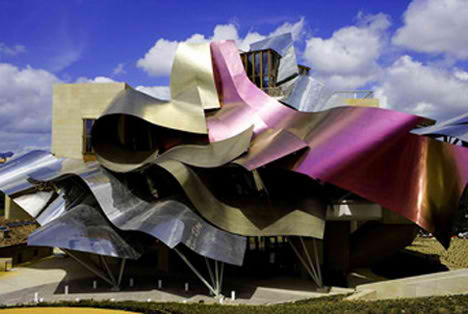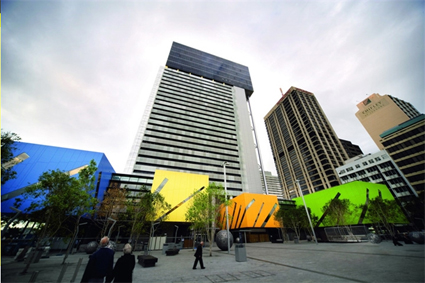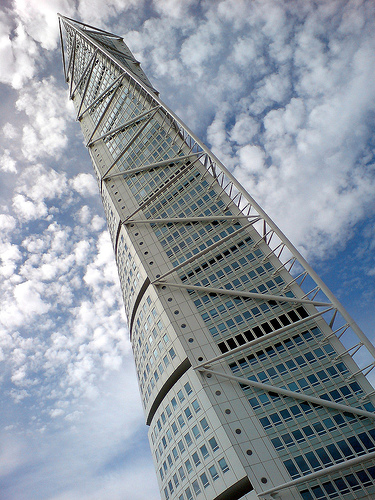


Looking at these examples of relatively recent architecture, one could say that they look affected, distorted, broken, wonky. It doesn’t take much imagination to associate these building with that trend in electronic music known as wonky. In fact, it is possible to spot a number of parallels (well, wonky lines) between trends in contemporary architecture and “wonky”.
Most obviously, the buildings literally look wonky. They bend, they twist, they appear to collapse or leap, their masses shift and cantilever – put simply their forms appear “out of place, out of key and misshapen” to borrow from Alex SBA.
Most obviously, the buildings literally look wonky. They bend, they twist, they appear to collapse or leap, their masses shift and cantilever – put simply their forms appear “out of place, out of key and misshapen” to borrow from Alex SBA.
Second, recent architecture has been awash in bright colour due to increasing whimsy on the architects’ behalf as well as advances in synthetic cladding. This calls to mind the common synesthetic tendency to associate the multi-textured and pitch-bent synths of wonky with bright day-glo colour.

Brisbane Square - bright colours for an optimistic city.
Third, quite like the way a wonky track with its unquantised percussion interrupts the steady rhythmic flow of non-wonky tracks in a mix, there are buildings which create an intentional disharmony with the surrounding urban form.
The Nationale-Nederlanden building in Prague (below), colloquially known as “Dancing House", takes the classical European urban form and distorts it by placing the windows in an unexpected pattern off the established grid set by the adjacent buildings ("unquantised windows", if you will), thereby disrupting the conventional rhythm of articulation on the façade. Moving further along and around the corner, the building squeezes itself into an organic hour-glass shape, the glazed façade allowing us to the see the supporting beams and columns twisted and distorted in defiance of the engineer’s grid, before it returns to a less affected pattern to "mix-out" into the neighbouring classical building.


A final parallel could be seen between the overall extravagance and visual sensation of these buildings and the dramatic arpeggios of a producer like Zomby. The rapid climb of notes in Kaliko (painstakingly transcribed by RF here) is akin to the dramatic oblique ascent of windows on Gehry’s Stata Centre, the twisting beams of Calatrava’s Turning Torso or the interior of Libeskind's Denver Art Museum.



This analogy between wonky music and wonky architecture is an easy one to draw and similar ideas have been expressed about the similarities between wonky and the avant-garde processes in art of the early 20th Century (Rouge's Foam once again).
However, it can be said that there is more than just an aesthetic dimension which relates wonky with architecture - both practices have a duty to perform. For the former, it is to sustain a rhythm (for dancing or listening pleasure), for the latter, it is to provide useable indoor space. For all its wonkiness, wonky is still dance music and must sustain an identifiable rhythm. How obvious the rhythm is or isn’t is part of the appeal of this music but nevertheless, it has to be there, in some form, with at least the kick drum returning to the first beat of every bar or two. Here I would refer to Kode 9 and Kodwo Eshun’s concept of “metric drift” which describes the way elements of a track “drift” away from the metronome but return to the first beat of the bar to maintain the rhythmic pulse.
Just as wonky must maintain a constant rhythm despite itself, wonky buildings must contain useable floors. As weird as wonderful as the building may be, the floors must still be horizontal and there must be enough of them to provide the useable real estate to justify its existence. Although it is common for the floor-to-ceiling height of each floor to vary, standardisation means that there is an identifiable “rhythm of floors” within a building , particularly apparent in commercial skyscrapers.


Wonky on the outside, the section view of Max Reinhardt Haus reveals the contrast and interplay between the rigidity of the building’s commercial duty to provide floorspace and the architect’s desire to transcend it.
Just like the music, wonky architecture is predicated on the requirement to perform a function characterised by repetition. And it is this precarious balance between performing this function and failing beautifully which is essential to the idea of “wonkification”.
The Role of Digital Design
In his book Skyscraper, Eric Howeler writes “the complexity of some recent skyscrapers reflects the increased use of the computer as a design tool. Many of the projects in this chapter would never have been built without computer-aided design and 3D-modelling software”. Although he’s talking about buildings, he might as well be talking about electronic music. Matthew Woebot Ingram points to the rise of softsynths, synthesisers that run completely on a pc or mac and which allow for total micro-control, as a key factor in wonky. By “simplifying the technicalities”, producers are afforded ample room for experimentation, just as architects are freed from the constraints of worrying if their buildings will stand up when powerful software can do that for them.
***
Although this analogy of architecture as wonky may be stretching it in some respects, it is easy to see some similarity in the processes and products of each practice. And with this post I hope to prove that it is indeed meaningful to dance about architecture (ha! groan) .
Amazing post! There's also the (albeit a little milder) Peckham Library - quite a landmark and one of an increasing number of buildings to make a feature of colour and 'wonkiness' that are now part of the townscape of such suburban centres around London... the homes of Grime and Dubstep of course.
ReplyDeletehttp://91090.cn/wp-content/uploads/2009/03/1675_peckham-library.jpg
Wonky indeed. It makes me wonder if time will be kinder to the music or the architecture.
ReplyDeleteI enjoyed your article. The social contexts for each 'wonky' movement are entirely different of course, and architects such as Koolhaus, Gehry have long been considered key artists of 'postmodernism' (yuk). what are some of the social connections between these parallel movements? Or is 'wonky' music part of an appropriation or reinvention of high postmodern (internationalist) architecture?
ReplyDeleteThank you Gemma.
ReplyDeleteThe social production of buildings and music could not be more different so it would be difficult to find any real social links between wonky and wonky architecture.
Wonky Architecture, I believe, is the result of the cult of the “starchitect”. Cities, in a bid to attract global attention in an increasingly delocalised world, are enlisting big brand architects like Gehry to plonk down the next Guggenheim museum in the hope of improving the city’s brand image and attracting investment. Novelty is key here, and it is a novel building (read: wonky building) designed by a household name architect which gets a city in design magazines and travel books. This is the socio-economic context in which gets wonky buildings built.
Wonky music, being an obscure electronic music genre, exists relatively independent of larger socio-economic factors. It is a cottage industry requiring few actors (artist and label manager in essence). So the social context of each practices’ material production is difficult to reconcile.
Are wonky producers appropriating architecture? I don’t know, you would have to ask them. Personally, I don’t think so. The similarities are limited to the aesthetic and so for me ‘wonky’ is a formalist concept applying only to the technical production of each art and not to their social or political production.
As to whether wonky is an attempt to create an aesthetic which is relevant and responsive to our fast changing times/globalisation/late capitalism etc is something I haven’t given much thought to (and a quite a bit of thought would be required to even entertain an answer). I apologise if this was the angle of your question.